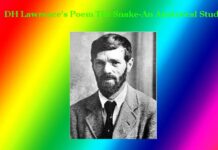Manmohan Ghose | Poplar Beech and Weeping Willow | A Critical Analysis
Manmohan Ghose | Poplar Beech and Weeping Willow | A Critical Analysisis
Manmohan Ghose | Poplar Beech and Weeping Willow | A Critical Analysis
The poem entitled, ‘Poplar, Beech and Weeping Willow’ by Manmohan Ghose is a romantic nature poem. In this poem, the title words which are the names of trees are shown as personified objects of nature and human activities are imputed upon them. In this poem, the poet seeks a world that is full of natural freedom. The poet, like Wordsworth, wants to seek a lesson from nature and thus nature for him stands as a teacher, a guide, and a philosopher.
First, the poet says about ‘poplar’ (a kind of plain tree) which is white in colour and standing lofty like a maiden. It, like a human being, is thinking and musing over something which the poet does not know. The tree is light in weight and it seems that it is always in a gay mood. So the poet asks the tree to teach him its secret thought so that the poet may be as gay as the tree. The poet experiences that the earth is full of grief and passion, so the poet asks the poplar tree to spring with the poet and to soar up the sky as to leave the word of grief and there to have peace. There, in the sky the floating clouds and the stars shall be their palace and the clouds and the stars will offer the tree and the poet a world of beauty. There the birds will sing a song to their pleasure. In the sky, they will flourish and live with the breeze in peace.
Secondly, the poet says about ‘Beech’ (a kind of oak tree with edible acorns). Beech is said to be the queen of all trees. It gives shade to every being. It is very tall, but the poet asks her to soar up to heaven i.e. to grow taller so that it can give more shadow. Now the poet asks her to teach him the lesson with which the poet can grow taller and can give shade to all. More the poet asks her to soar sunward, with the poet so that the poet along with the tree can take shelter for the shepherd to save and protect them from the heat of the sun. Sitting on the branches of the trees, the bird sings a melodious song to please all who listen to the song. Thirdly, the poet says about the Willow. He sees her weeping more and drenching her soul with tears and by doing so she will experience the agony of love and separation. At last, the poet asks her to sour up so as to touch the bright stars and the moon. Thence she will be able to see the birth of brooks and will experience the emotion of the pines. And then, she will be able to catch the sound of the broadening stream and the swell of the ocean.
From the detailed analysis of the poem, it is learned that the poet is tiresome of the man-made society where he gets only pain, sorrow and agony and he desires to soar up skyward as to live in peace. The poem is Wordsworthian in theme and ideal.
The whole poem is the imagery of soaring skyward— but the imageries are hyperbolic and though they are hyperbolic yet the imageries fail to fascinate our senses.
The poem is written in a four-lined stanza in which the rhymes of the lines become the same. In this poem, the poet has used some alliteration (alliteration is a kind of figure of speech that consists of the repetition of the same letter or syllable at the beginning of two or more words). For example,
(a) Poffer their pure world of pomp.
(b) Soaring to a tower of sighs in branches soft and shady.
(c) Beauty into bounty change,
Bend down the eye that blesses. 0 0 0
Manmohan Ghose | Poplar Beech and Weeping Willow | A Critical Analysis
Read More: The Poetry of Manmohan Ghose-Chief Features
N. B. This article entitled ‘Manmohan Ghose’s Poem ‘Poplar, Beech and Weeping Willow’- A Critical Analysis’ originally belongs to the book ‘Indian English Poetry Criticism‘ by Menonim Menonimus. Manmohan Ghose | Poplar Beech and Weeping Willow | A Critical Analysis
Books of Literary Criticism by M. Menonimus:
- World Short Story Criticism
- World Poetry Criticism
- World Drama Criticism
- World Novel Criticism
- World Essay Criticism
- Indian English Poetry Criticism
- Indian English Poets and Poetry Chief Features
- Emily Dickinson’s Poetry-A Thematic Study
- Walt Whitman’s Poetry-A Thematic Study
- Critical Essays on English Poetry
- Tawfiq al-Hakim’s Novel: Return of the Spirit-An Analytical Study
- Tawfiq al-Hakim’s Novel: ‘Yawmiyyat Naib Fil Arayaf’-An Analytical Study
- Analytical Studies of Some Arabic Short Stories
- A Brief History of Arabic Literature: Pre-Islamic Period …
Books of Composition by M. Menonimus:
- Advertisement Writing
- Amplification Writing
- Note Making
- Paragraph Writing
- Notice Writing
- Passage Comprehension
- The Art of Poster Writing
- The Art of Letter Writing
- Report Writing
- Story Writing
- Substance Writing
- School Essays Part-I
- School Essays Part-II
- School English Grammar Part-I
- School English Grammar Part-II..
Related Searches:
- The Individual and Society-Guide Book
- The Individual and Society-DU Notes
- The Golden Treasury of Indo-Anglian Poetry
- Indian Poetry-A Survey by Satish Kumar
- The Harp of India-Henry Derozio
- ‘To the Moon’-Henry Derozio
- Night of Slaughter Duryodhan’s Death
- Ramesh Chunder Dutt’s Poem ‘Sita Lost’
- ‘Kali the Mother a Poem by Vivekananda
- Beloved My Beloved
- London by Manmohan Ghose
- Can It Be by Manmohan Ghose
- The Garden Passion
- Poplar, Beech and Weeping Willowby Manmohan Ghose …











